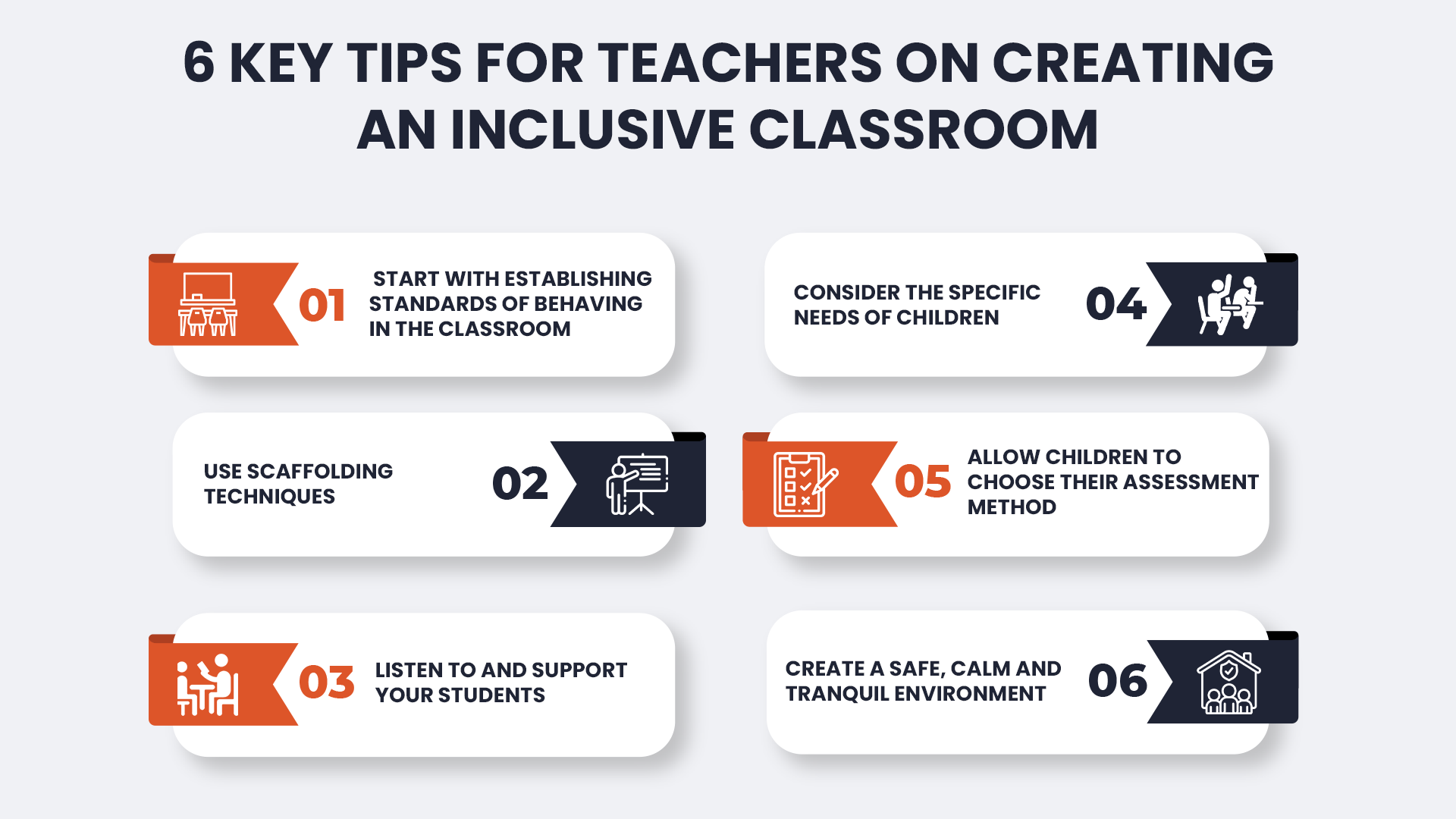Imagine belonging to a classroom where diversity is appreciated; you feel a sense of belonging and where learning thrives amidst unique and individual perspectives. But, how can we establish an inclusive learning setting that welcomes students from all walks of life?
In this blog post, we have mentioned the importance and benefits of inclusion and effective tips on how you can build an inclusive classroom; plant seeds of acceptance, shape young minds and cultivate a classroom that promotes academic excellence which also helps you nurture a garden of diverse minds.
What Does Inclusion Mean in Education?
Inclusion in education simply means that regardless of a learner’s background and differences, each avails equal access to learning and opportunities.
In other words, it does not mean that learners should be provided with additional support but it is more about cultivating and fostering a learning environment for all students regardless of their native language or minority status.

What is the Importance of Inclusive Education?
Do you know that inclusive classrooms show more than a 65% increase in academic performance compared to non-inclusive ones? We cannot consider inclusion in education as merely a buzzword; as educators and teachers, you hold the power to change young minds and shape their futures by implementing the right strategies and methods during your lessons, which we’ll discuss shortly, will allow children to actively participate, learn and grow intellectually.
Although the main aim of inclusive education is to ensure all students are treated fairly without discrimination, here is how it can make a huge difference:
- All students in the classroom will develop a sense of belonging and be better prepared for life.
- Students, regardless of their abilities, will be motivated, leading to the development of their strengths and gifts,
- All students’ needs are met which allows students to work on their own goals while being with others.
- It fosters a culture of respect and provides an opportunity to learn diverse perspectives.
Simply put, by bringing students from all walks of life, inclusive education can help you, as a teacher, cultivate and foster a positive learning environment.
On another note, if you are looking to teach and train in the educational sector, you can enrol on our Level 3 Award in Education and Training, previously referred to as the PTLLS qualification, which will help you learn about inclusive education and how to implement several effective methods and strategies in the classroom to meet each individual’s needs.
6 Key Tips for Teachers on Creating an Inclusive Classroom
We are about to discuss some helpful and key tips on how teachers can create an inclusive classroom which benefits all students.
1. Start With Establishing Standards of Behaving in the Classroom
Sometimes, children can be quite hard to handle; therefore, setting some rules regarding behaviour would be extremely helpful. All children must be aware of acceptable and unacceptable behaviours. A highly effective approach is to create a chart and establish guidelines on it. You could involve children in creating this chart or designing classroom rules display to make it more fun and engaging. However, make sure that rules are concise and understandable emphasising that everyone feels safe and respected in the classroom.
You can write simple rules such as:
- Be kind and humble and use kind words when addressing others
- Keep your hands to yourself
- Always respect the space of your friends and others
- Feel free to share your thoughts and feelings etc.,
Not only that, enforcing these rules is equally important as establishing them. If someone misbehaves, ensure to give them an initial warning – gently talk to them that how their behaviour is hurtful and unacceptable to others.
2. Use Scaffolding Techniques
Imagine your classroom as a bustling metropolis: filled with unique learners having their own learning styles and you are their leader. This is where the magic of scaffolding comes in; using scaffolding techniques is like a secret sauce in making classrooms more inclusive.
Teachers act as architects, designing and paving paths that cater to their student’s unique learning needs; to effectively implement this strategy, you can,
- Help your students break the task into small chunks that feel more achievable,
- Help students through their assigned tasks and encourage them while they complete them,
- Group them and assign them fun activities so they can learn to work in teams, support and respect each other.
3. Listen to and Support Your Students
A classroom is a melting pot of several cultures, backgrounds and perspectives. Each student with their own thoughts, dreams and stories, waiting to be seen and heard. While planning your lessons, do try to schedule some time to listen to their thoughts and teach them to understand their peers respectfully as well.
On the other hand, sometimes students quarrel with each other; in such an event this may be crucial when resolving conflicts among them in your class. Try to connect with your students emotionally and ask them why they were upset and what led to occur such an incident.
When you create these opportunities, students will feel included and they will engage more in learning.

4. Consider the Specific Needs of Children
Considering the needs of all students in your classroom, including those with ADHD or autism, is crucial. Although sitting on a carpet might seem like an inclusive approach, it may not be suitable for these students to sit and listen for extended periods of time. It is equally important to identify students with Special Educational Needs and Disabilities, those with English as an Additional Language (EAL), or who belong to traveller communities. This can help you provide better support for each student’s individual requirements.
5. Allow Children to Choose their Assessment Method
One of the most important questions asked by teachers is how can we assess all students in the classroom. And the simplest answer would be as the ‘one size fits all’ approach doesn’t work while teaching, it cannot work while assessing students; therefore, you need to create opportunities where you can assess students learning progress using different methods. Usually, we all take a written test after completing the lesson, don’t do that; instead, ask your students how would they like to be assessed and show their learning progress.
You can ask them to:
- Write a blog or essay,
- Make a flowchart or create an infographic
- Or make a presentation
This method is not only inclusive but it is also empowering for students for showcasing their learning progress as per their assessment method.
6. Create a Safe, Calm and Tranquil Environment
Though the classroom is a sanctuary for young minds to grow, creating such an oasis for learning may be challenging. Learning blended with tranquillity creates a perfect inclusive classroom. Your students need a serene, calm and warm atmosphere in order to learn and grasp the concepts better.
In order to do this, you can fill your classroom with objects like:
- A large table for group activities
- Indoor plants,
- Toys,
- Visual Aid such as SMART Board
Conclusion
Creating a classroom environment that is inclusive and makes every student feel welcome, valued, and like they belong is essential. A classroom may consist of students from all walks of life including different backgrounds and religions. Therefore, we have mentioned some tips for teachers on how to create an inclusive classroom and learning environment where each student feels included.
Related Products
-
Focus Awards Level 3 Award in Education and Training (RQF)
Rated 5.00 out of 5£29.67 – £160.00 Select options -
Focus Awards Level 4 Certificate in Education and Training (RQF)
Rated 5.00 out of 5£61.18 – £480.00 Select options -
Focus Awards Level 5 Diploma in Education and Training (RQF)
Rated 5.00 out of 5£91.89 – £960.00 Select options




